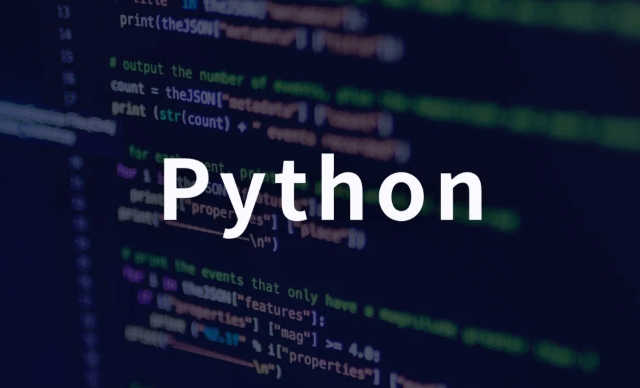Implementing circuit breakers in Python microservices is to improve fault tolerance and prevent avalanche effects. 1. It is recommended to use the circuitbreaker library, which is integrated through the decorator mode, such as setting failure_threshold=5 and recovery_timeout=60; 2. You can combine the retry mechanism of the tenacity library, try to recover first and then fuse, such as 1 second interval of 3 retry intervals; 3. The parameters should be adjusted according to the business scenario, high concurrency services should increase the threshold, low-frequency key calls should lower the threshold, and dynamic injection configuration should be considered; 4. Logs and monitoring the circuit breaking status must be recorded, and the alarm system should respond to abnormalities in a timely manner. The above measures jointly ensure service stability.

Implementing a circuit breaker in Python microservices is mainly to enhance the system's fault tolerance and prevent the avalanche effect. Simply put, when a dependent service fails, the circuit breaker can prevent subsequent requests from continuing to send to the service, and instead return a downgrade response or a direct error, thereby protecting the entire system.

Here are some practical practices and suggestions:
1. Use third-party libraries to simplify implementation
The Python community has several mature libraries that can help you quickly introduce circuit breaker mechanisms, such as circuitbreaker and tenacity .

It is recommended to use circuitbreaker , which provides a decorator pattern that is very convenient to integrate into your functions or methods.
The sample code is as follows:

from circuitbreaker import circuit
@circuit(failure_threshold=5, recovery_timeout=60)
def call_external_service():
# Here is the logical response of the external service called = requests.get('http://external-service/api')
return response.json()In the example above:
-
failure_threshold=5means that the circuit breaker is triggered after 5 consecutive failures. -
recovery_timeout=60means that recovery is attempted 60 seconds after the circuit is turned on.
This writing method is concise and easy to maintain, and is suitable for most REST calling scenarios.
2. Combining the retry mechanism to improve robustness
The circuit breaker itself is just "fuse" and is not responsible for retrying. But usually we use it in conjunction with the retry mechanism so that we can try to recover on the first failure rather than circuit breaking immediately.
You can use tenacity to retry, and then use it with the circuit breaker to form a more complete error handling strategy.
For example:
from tenacity import retry, stop_after_attempt, wait_fixed
from circuitbreaker import circuit
@circuit(failure_threshold=3, recovery_timeout=30)
@retry(stop=stop_after_attempt(3), wait=wait_fixed(1))
def fetch_data_from_api():
resp = requests.get('http://some-api/data')
resp.raise_for_status()
return resp.json()here:
- Retry up to 3 times first, each time interval is 1 second
- If all 3 times fail, the circuit breaker count is counted
- When the failure reaches the threshold, the circuit is disconnected and the target interface is stopped for a period of time
Such a combination can effectively reduce service disruptions due to temporary network fluctuations.
3. Adjust parameters according to business scenarios
Circuit breakers are not static configurations, and parameters should be adjusted according to actual business needs:
- High concurrency core service : failure_threshold can be appropriately improved to avoid mis-fuse fuse
- Low frequency but key calls : For example, payment callbacks can be set to circuit breaker if the number of failures is set
- Recovery time selection : recovery_timeout To be reasonable, too short may lead to frequent switching of states, too long may affect user experience
For example:
If your service is only called a few times per minute, setting failure_threshold to 2 is sufficiently sensitive; but if it is a high frequency API, setting it to 10 is more appropriate.
In addition, it is also possible to consider dynamically injecting these parameters through the configuration center to facilitate operational adjustment.
4. Monitoring and logging cannot be missing
Once the circuit breaker takes effect, it means that your service has abnormalities, and monitoring and logging are very important at this time.
suggestion:
- Logs are recorded when the fuse occurs, including the current number of failures, fuse status, etc.
- Report the circuit breaker status with Prometheus or StatsD
- Connect to the alarm system and notify the operation and maintenance personnel if the fuse duration is too long
For example, add a callback function:
def on_circuit_open():
logger.warning("Circuit breaker is now OPEN!")
metrics.increment("circuit_breaker.open")
@circuit(failure_threshold=5, recovery_timeout=60, on_open=on_circuit_open)
def some_important_call():
...This helps you to be aware of and respond to problems as soon as they occur.
Basically that's it. Circuit breakers are not omnipotent, but they can provide an important protection mechanism in the microservice architecture. The key is to configure and use it reasonably according to your own business situation.
The above is the detailed content of Implementing Circuit Breakers in Python Microservices. For more information, please follow other related articles on the PHP Chinese website!

Hot AI Tools

Undress AI Tool
Undress images for free

Undresser.AI Undress
AI-powered app for creating realistic nude photos

AI Clothes Remover
Online AI tool for removing clothes from photos.

Clothoff.io
AI clothes remover

Video Face Swap
Swap faces in any video effortlessly with our completely free AI face swap tool!

Hot Article

Hot Tools

Notepad++7.3.1
Easy-to-use and free code editor

SublimeText3 Chinese version
Chinese version, very easy to use

Zend Studio 13.0.1
Powerful PHP integrated development environment

Dreamweaver CS6
Visual web development tools

SublimeText3 Mac version
God-level code editing software (SublimeText3)
 Polymorphism in python classes
Jul 05, 2025 am 02:58 AM
Polymorphism in python classes
Jul 05, 2025 am 02:58 AM
Polymorphism is a core concept in Python object-oriented programming, referring to "one interface, multiple implementations", allowing for unified processing of different types of objects. 1. Polymorphism is implemented through method rewriting. Subclasses can redefine parent class methods. For example, the spoke() method of Animal class has different implementations in Dog and Cat subclasses. 2. The practical uses of polymorphism include simplifying the code structure and enhancing scalability, such as calling the draw() method uniformly in the graphical drawing program, or handling the common behavior of different characters in game development. 3. Python implementation polymorphism needs to satisfy: the parent class defines a method, and the child class overrides the method, but does not require inheritance of the same parent class. As long as the object implements the same method, this is called the "duck type". 4. Things to note include the maintenance
 Explain Python generators and iterators.
Jul 05, 2025 am 02:55 AM
Explain Python generators and iterators.
Jul 05, 2025 am 02:55 AM
Iterators are objects that implement __iter__() and __next__() methods. The generator is a simplified version of iterators, which automatically implement these methods through the yield keyword. 1. The iterator returns an element every time he calls next() and throws a StopIteration exception when there are no more elements. 2. The generator uses function definition to generate data on demand, saving memory and supporting infinite sequences. 3. Use iterators when processing existing sets, use a generator when dynamically generating big data or lazy evaluation, such as loading line by line when reading large files. Note: Iterable objects such as lists are not iterators. They need to be recreated after the iterator reaches its end, and the generator can only traverse it once.
 How to handle API authentication in Python
Jul 13, 2025 am 02:22 AM
How to handle API authentication in Python
Jul 13, 2025 am 02:22 AM
The key to dealing with API authentication is to understand and use the authentication method correctly. 1. APIKey is the simplest authentication method, usually placed in the request header or URL parameters; 2. BasicAuth uses username and password for Base64 encoding transmission, which is suitable for internal systems; 3. OAuth2 needs to obtain the token first through client_id and client_secret, and then bring the BearerToken in the request header; 4. In order to deal with the token expiration, the token management class can be encapsulated and automatically refreshed the token; in short, selecting the appropriate method according to the document and safely storing the key information is the key.
 Explain Python assertions.
Jul 07, 2025 am 12:14 AM
Explain Python assertions.
Jul 07, 2025 am 12:14 AM
Assert is an assertion tool used in Python for debugging, and throws an AssertionError when the condition is not met. Its syntax is assert condition plus optional error information, which is suitable for internal logic verification such as parameter checking, status confirmation, etc., but cannot be used for security or user input checking, and should be used in conjunction with clear prompt information. It is only available for auxiliary debugging in the development stage rather than substituting exception handling.
 How to iterate over two lists at once Python
Jul 09, 2025 am 01:13 AM
How to iterate over two lists at once Python
Jul 09, 2025 am 01:13 AM
A common method to traverse two lists simultaneously in Python is to use the zip() function, which will pair multiple lists in order and be the shortest; if the list length is inconsistent, you can use itertools.zip_longest() to be the longest and fill in the missing values; combined with enumerate(), you can get the index at the same time. 1.zip() is concise and practical, suitable for paired data iteration; 2.zip_longest() can fill in the default value when dealing with inconsistent lengths; 3.enumerate(zip()) can obtain indexes during traversal, meeting the needs of a variety of complex scenarios.
 What are python iterators?
Jul 08, 2025 am 02:56 AM
What are python iterators?
Jul 08, 2025 am 02:56 AM
InPython,iteratorsareobjectsthatallowloopingthroughcollectionsbyimplementing__iter__()and__next__().1)Iteratorsworkviatheiteratorprotocol,using__iter__()toreturntheiteratorand__next__()toretrievethenextitemuntilStopIterationisraised.2)Aniterable(like
 What are Python type hints?
Jul 07, 2025 am 02:55 AM
What are Python type hints?
Jul 07, 2025 am 02:55 AM
TypehintsinPythonsolvetheproblemofambiguityandpotentialbugsindynamicallytypedcodebyallowingdeveloperstospecifyexpectedtypes.Theyenhancereadability,enableearlybugdetection,andimprovetoolingsupport.Typehintsareaddedusingacolon(:)forvariablesandparamete
 Python FastAPI tutorial
Jul 12, 2025 am 02:42 AM
Python FastAPI tutorial
Jul 12, 2025 am 02:42 AM
To create modern and efficient APIs using Python, FastAPI is recommended; it is based on standard Python type prompts and can automatically generate documents, with excellent performance. After installing FastAPI and ASGI server uvicorn, you can write interface code. By defining routes, writing processing functions, and returning data, APIs can be quickly built. FastAPI supports a variety of HTTP methods and provides automatically generated SwaggerUI and ReDoc documentation systems. URL parameters can be captured through path definition, while query parameters can be implemented by setting default values ??for function parameters. The rational use of Pydantic models can help improve development efficiency and accuracy.






